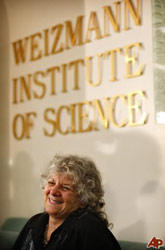
Handy Links
SLAC News Center
SLAC Today
- Subscribe
- Archives: Feb 2006-May 20, 2011
- Archives: May 23, 2011 and later
- Submit Feedback or Story Ideas
- About SLAC Today
SLAC News
Lab News
- Interactions
- Lightsources.org
- ILC NewsLine
- Int'l Science Grid This Week
- Fermilab Today
- Berkeley Lab News
- @brookhaven TODAY
- DOE Pulse
- CERN Courier
- DESY inForm
- US / LHC
SLAC Links
- Emergency
- Safety
- Policy Repository
- Site Entry Form

- Site Maps
- M & O Review
- Computing Status & Calendar
- SLAC Colloquium
- SLACspeak
- SLACspace
- SLAC Logo
- Café Menu
- Flea Market
- Web E-mail
- Marguerite Shuttle
- Discount Commuter Passes
-
Award Reporting Form
- SPIRES
- SciDoc
- Activity Groups
- Library
Stanford
Around the Bay
Nobel Laureate Did Landmark Work at SSRL
Last month, Ada Yonath became the fourth woman in history to win a Nobel Prize in Chemistry, which she shared with Thomas Steitz and Venkatraman Ramakrishnan for "studies of the structure and function of the ribosome." As many of her colleagues will attest, it wasn't always clear that Yonath was headed for great success. For more than a decade, her passionate, unwavering study of the ribosome looked to many like a dead end. A major breakthrough in her work, and a turning point in the opinion of her peers, happened in 1987 at the Stanford Synchrotron Radiation Lightsource, SSRL.
It was polar bears that got Yonath interested in the human ribosome: she read a book about polar bears, and wondered what kind of mechanism would preserve the bears' ribosome so they wouldn't fall apart or be degraded during hibernation. The Ribosome is perhaps the most essential structure within our cells. They read the plans carried in DNA through its intermediary, messenger RNA, to build the proteins necessary for life. The delicate ribosome was easily destroyed under examination, but knowing that nature had its own method of preserving it made Yonath believe that there must be a way to crystallize and study it.
Many of her colleagues didn't agree. By 1980, scientists had already learned how to crystallize proteins, which "froze" them in place, although the crystals were held near room temperature. Crystallization allowed the proteins to be examined under synchrotron light, but the process was new, and only small and robust proteins could survive it.
By 1980 Yonath had overcome an initial wave of skepticism and successfully crystallized ribosome particles, which is a rather large and delicate structure of proteins and RNA. But even the crystallized ribosome dissolved in the synchrotron X-ray beam in a few minutes, not nearly enough time for Yonath to collect enough useful data, and at times she struggled to stay focused on her goal.
In early 1987 Yonath and her long-time friend Håkon Hope arranged to meet at SSRL where Yonath and a team of researchers were headed to do work at one of the beam lines. Hope was working at the University of California Davis, and was studying techniques for cooling proteins with liquid nitrogen. The process made the proteins last much longer in the X-ray beam. Yonath had asked Hope if he could cool the delicate ribosome crystals and Hope told her he thought he could.
Arthur Bienenstock directed SSRL in the 1980's. In those days, users competed strongly for the available beam time because there were only a handful of synchrotrons in the world. He remembers that while Yonath was respected for her work, many of her colleagues worried that the problem she was taking on couldn't be solved.
"I had instructed the review panel [which ranks proposals for user beam time] to be sensitive to high risk, high gain experiments," said Bienenstock. "It's likely that she was perceived in that way. She was going after a very difficult problem. "
Hope, now Professor Emeritus at UC Davis, met Yonath and her group at SSRL and used liquid nitrogen to cool the ribosome samples. Previously, Yonath had watched helplessly as the X-ray beam destroyed the crystals in a few minutes. But on the very first run, she and Hope watched as the ribosome crystals survived the harsh X-rays for minutes, then hours, then days. In an e-mail to her colleagues to announce the results, Yonath told them, "We have given eternal life to the ribosome crystals."
In August 1987, Hope and Yonath made a poster to feature meeting of the International Union of Crystallographers in Perth, Australia, where Hope says they "drew in quite a crowd." He recalls his friend Paul Sigler, a well known crystallographer with a "big, big voice," shouting to a friend across the room as he pointed at Hope, "Come here and look at this poster! He's out to revolutionize our science!"
Yonath and Hope didn't formally publish results of their work until 1989, in a paper with nine other authors, and it was another ten years before Yonath and other biocrystallographers managed to create a visualization of the entire ribosome. Yonath and Steitz separately modeled the ribosome's larger subunit in 1999 and 2000, while Ramakrishnan imaged the smaller subunit in 1999. The time that Yonath and Hope spent at SSRL was one small but important step for Yonath's work and contributed to the growing wealth of knowledge about cold biocrystallography.
Yonath still studies the ribosome as the Director of the Centre for Biomolecular Structure and Assembly at Israel's prestigious Weizmann Institute of Science. She is part of an effort to get a synchrotron light source up and running in Jordan, near her home country of Israel. The Synchrotron-light for Experimental Science and Applications in the Middle East, SESAME, began beam injection last year.
—Calla Cofield
SLAC Today, November 16, 2009
